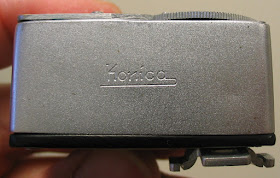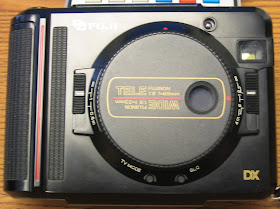This Konica meter by Konishiroku is more similar to the newer version of Sekonic meter, but with a different front plate, light sensor cover and fixed shoe position.
Monday, December 31, 2012
The User's Review: Konica Shoe-Mount Light Meter, Made in 1950 - 1960?
This Konica meter by Konishiroku is more similar to the newer version of Sekonic meter, but with a different front plate, light sensor cover and fixed shoe position.
The User's Review: Sekonic Shoe-Mount Light Meter, Released in 1950 - 1960?
I got two such shoe-mount light meters made by Sekonic. The features that I like on these meters are: incident or reflected readings, adjustable position of the foot on the meter, and zero screw.
There are some minor changes between the two meters. I refer them as the newer version (sn 081sss) and older version (sn 025sss)
On the newer version case, 'Made in Japan' is marked on the back.
The newer version (left) has a red needle with a mirror background.
In the two images above, the newer version is on the right. The newer version has labeled 'Made in Japan' on its bottom metal plate and has a strap ring on its foot.
In this image, older and newer versions are on left and right, respectively.
Konishiroku also produced a Koinca meter, more similar to the newer version of Sekonic here.
Friday, December 28, 2012
The User's Review: Fuji TW-3 Half-Frame 35 mm Compact Camera, Released in 1985
Today, TW-3 is a collector's item because of its rareness. Why it's rare, I believe, this is due to its unique design that caused its low demand in the market and limited production by its manufacture.
The unique design includes:
1. Compact body by the 1980's standard
2. Half frame of 35 mm film
3. 2 sets of lenses: telephoto (69 mm, 1.8) and wideangle (23 mm, 1.8).
4. Sealed battery chamber, meaning that its users can not change the battery by themselves after ~ 1000 shots (= ~ 14 rolls of 36 exp film, I doubt if this is a design by Japanese?)
The front lens cover has three positions to turn: Off
The front lens cover has three positions to turn: Wideangle lens and auto-lift flash
The front lens cover has three positions to turn: Tele lens
The viewfinder is too small to be comfort for a user like me wearing glasses. At the tele lens, a smaller bright-green frame will show up in the viewfinder to indicate the image edges.
The battery holder is on the left. Film will be pre-loaded onto the roller above the lens.
At the wideangle lens, the flash is up and the mirror (on the left of the lens) covers the light path from the tele lens.
At the tele lens, the mirror is open and light comes in via the tele lens
Am I happy to own a TW-3? Yes, because it's rare.
Do I like to use my TW-3? No, because it's unique design.
Should I recommend a TW-3 to you? It's up to you.
Thursday, December 27, 2012
The User's Review: Konica UC Zoom Hexanon AR 45 - 100 mm F3.5, released in 1980s?
This zoom lens is one of four Konica UC Hexanon lens family, including 15mm F2.8, 28mm F1.8, and 80 -200 mm F4. The UC has triple meanings: Ultra Compact, Ultra Close-up and Ultra Coating. Like its older sibling Konica 47 - 100 zoom lens, this version with 45 - 100 mm is also rare.
Friday, December 21, 2012
The User's Review: Yashica Fx-3/Fx-7, Fx-3/Fx-7 Super and Fx-3 Super 2000, A Legend Since 1979
I should write my first camera review on Fx-3 since it is my first camera that my dad bought for me from Hong Kong in early 1980s. I used it as my main camera body until mid-2000.
I use these sentences 'the simpler the better, and less is more' to describe my Fx-3. It's a all manual body with an on-board light meter powered by two cell batteries. You can learn how to use it without referring to its manual. The design was so successful that Yashica made several minor improved models (see the table below), and other camera manufactures, as I believe, produced some cameras based on the design of Fx-3. The similar design and interchangeable parts can be found on Vivitar 3800N and V3000S, Promaster 2500 PK, Centon K100 and Kalimar K-90 although these cameras have the Pentax K lens mount. All black of Yashica models is more common than the silver top/bottom plates of Yashica. I prefer the all blacks because wearing is more obvious on the silvers.
Fx-3/Fx-7
|
Fx-3 Super/Fx-7 Super
|
Fx-3 Super 2000
|
|
Top & bottom color
|
Black/Silver
|
Black/Silver
|
Black or Silver
|
Bottom plate material
|
Brass
|
Plastic (?)
|
Plastic
|
Grip
|
No
|
Yes
|
Yes
|
Top speed (sec.)
|
1/1000
|
1/1000
|
1/2000
|
Meter activation switch
|
Check button under film advance level
|
Shutter release button half way
|
Shutter release button half way
|
I consider the three following reasons for having a Fx-3 or its sibling models: 1. Easy to use; 2. light weight; and 3. low-cost use of high-end lens of Contax and Zeiss.
Fx-3 and its Yashica siblings do not have DOF, PC socket, mirror lock(although the self timer locks the mirror right after triggered) and multiple exposures. There is no switch to shut down the meter lights in the viewfinder. Therefore, the user should take off the batteries before a long-time exposure shoot to avoid the red light exposes your film. The soft 'skin' on Fx-3/Fx-7 and Fx-3/Fx-7 Super is easy to wear off. My own Fx-3 had a problem with shutter release (film advance stuck) after ~10 yeas use. I had it repaired, but did not use it much since then.
I brought a Fx-3 Supper 2000 kit in Oct. of 2012. The body feels weaker and more plastic. The kit lens is a Yashica ML 50mm f1.9 c with a plastic mount. The lens' focusing ring was stuck and there was too much grease inside.
The User's Review: Konica AA-35, A Half Frame 35 mm Pocket Camera, Released in 1985
I got this camera in its original package with the shop receipt. As it and the price tags on the box showed, this camera was sold at a discount price of USD 59 at a Caldor store in New York on Nov. 17, 1985. The blue tag shows its original price of 79.94. To me, all these indicate that the camera was not hot when it first got on the market.
In today's standards for a pocket digital camera, Konica AA-35 is neither that compact. I believe, the camera lens is made of plastic, but coated. Every functions are auto except the manual setting for film speeds only at 100, 200 or 400 ISO.
The same model comes with two different model names, Konica AA-35 and Konica Recorder, and in two different colors (gold and black).
I list its pros here:
1. Small size 112.5 x 77 x 30.5 mm
2. Light weight 250 g with no battery
3. Everything auto except film speed setting
4. Half frame
In the current digital camera era, Konica AA-35 and Recorder become a collector's item and, for a camera in good conditions, its current price is doubled of the original one. Do I use my AA-35 as my daily camera? No, because I doubt its durability.
Fuji also produced a half-frame compact camera, TW-3 with 2 lenses.


































































